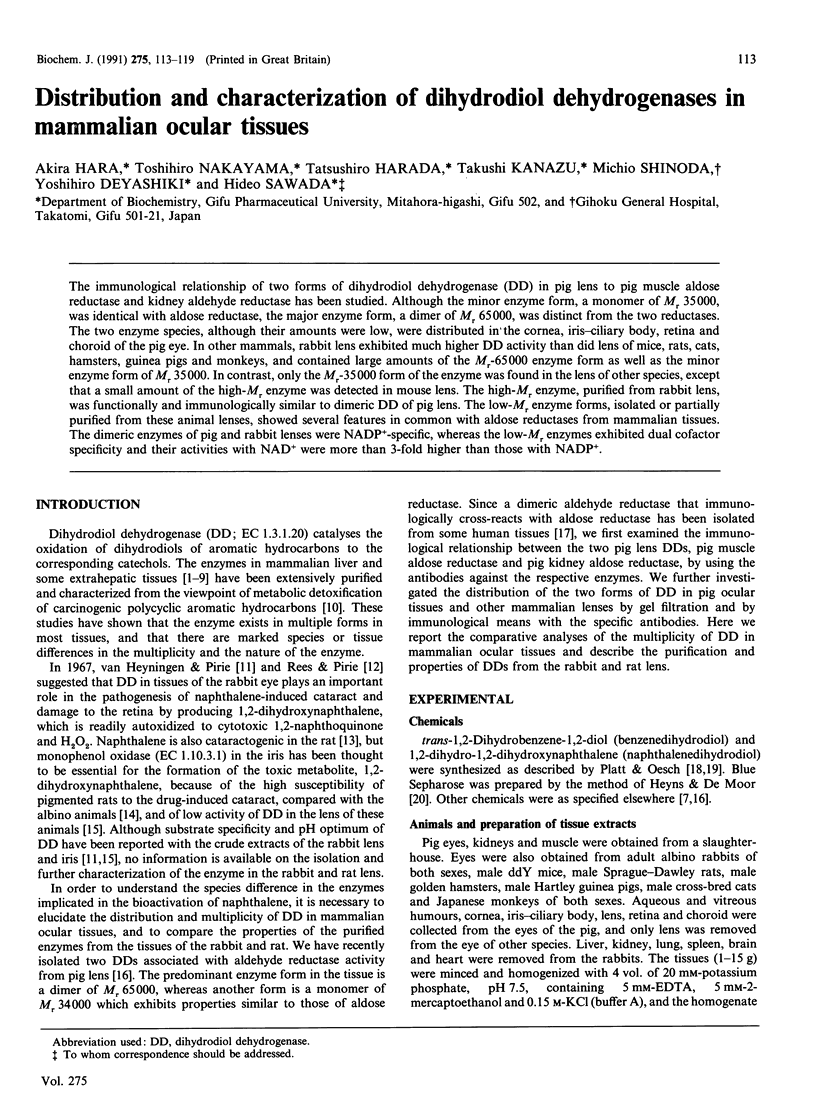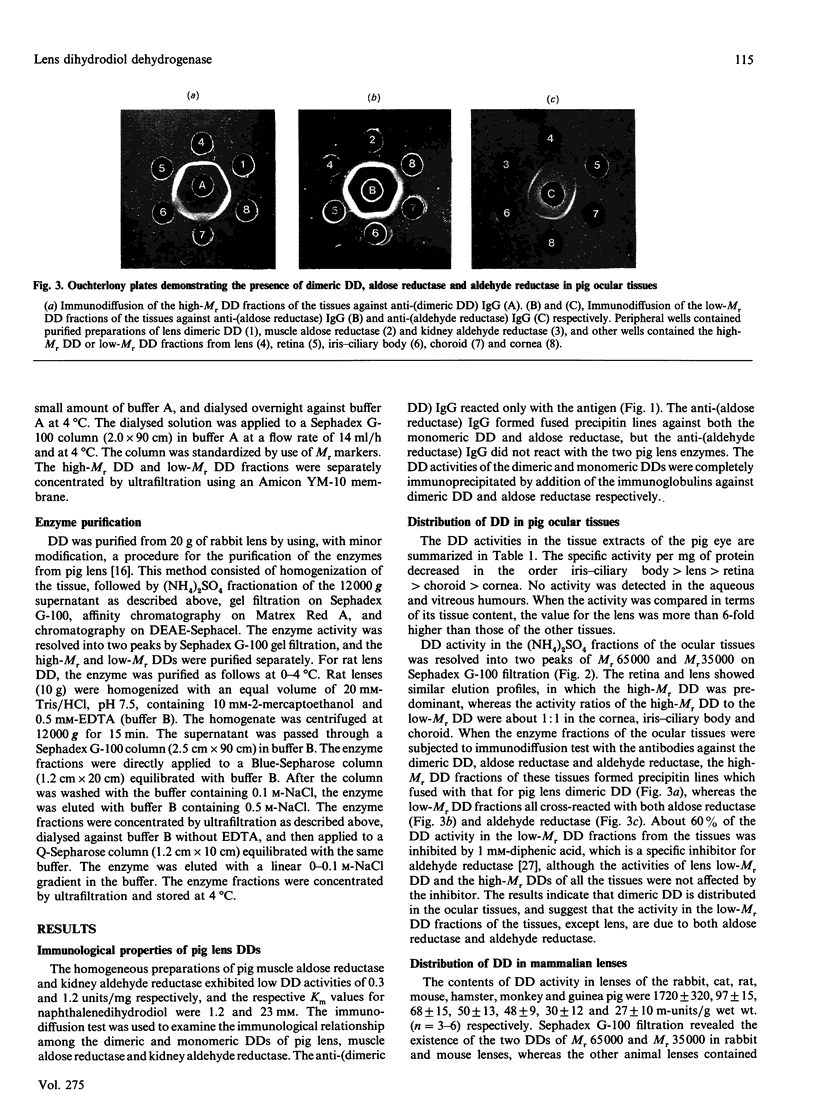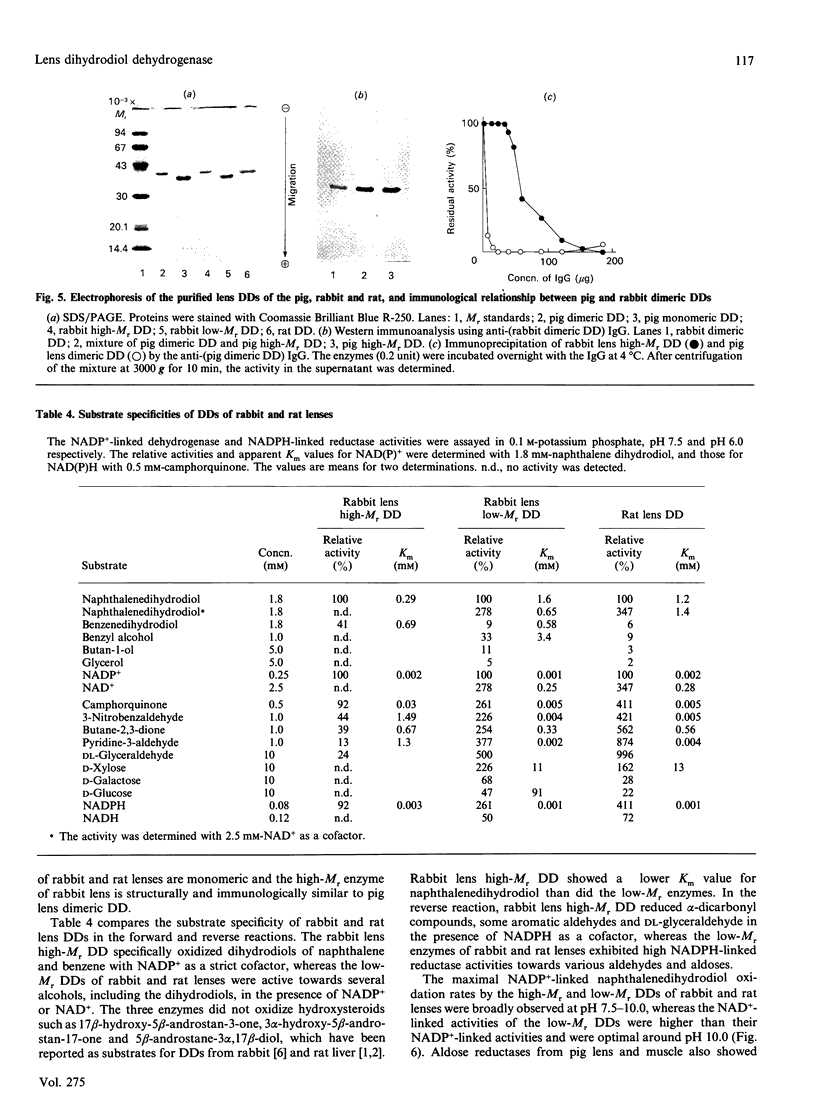Abstract
The immunological relationship of two forms of dihydrodiol dehydrogenase (DD) in pig lens to pig muscle aldose reductase and kidney aldehyde reductase has been studied. Although the minor enzyme form, a monomer of Mr 35,000, was identical with aldose reductase, the major enzyme form, a dimer of Mr 65,000, was distinct from the two reductases. The two enzyme species, although their amounts were low, were distributed in the cornea, iris-ciliary body, retina and choroid of the pig eye. In other mammals, rabbit lens exhibited much higher DD activity than did lens of mice, rats, cats, hamsters, guinea pigs and monkeys, and contained large amounts of the Mr-65,000 enzyme form as well as the minor enzyme form of Mr 35,000. In contrast, only the Mr-35,000 form of the enzyme was found in the lens of other species, except that a small amount of the high-Mr enzyme was detected in mouse lens. The high-Mr enzyme, purified from rabbit lens, was functionally and immunologically similar to dimeric DD of pig lens. The low-Mr enzyme forms, isolated or partially purified from these animal lenses, showed several features in common with aldose reductases from mammalian tissues. The dimeric enzymes of pig and rabbit lenses were NADP(+)-specific, whereas the low-Mr enzymes exhibited dual cofactor specificity and their activities with NAD+ were more than 3-fold higher than those with NADP+.
Full text
PDF






Images in this article
Selected References
These references are in PubMed. This may not be the complete list of references from this article.
- Bolcsak L. E., Nerland D. E. Purification of mouse liver benzene dihydrodiol dehydrogenases. J Biol Chem. 1983 Jun 25;258(12):7252–7255. [PubMed] [Google Scholar]
- Bradford M. M. A rapid and sensitive method for the quantitation of microgram quantities of protein utilizing the principle of protein-dye binding. Anal Biochem. 1976 May 7;72:248–254. doi: 10.1006/abio.1976.9999. [DOI] [PubMed] [Google Scholar]
- Branlant G. Properties of an aldose reductase from pig lens. Comparative studies of an aldehyde reductase from pig lens. Eur J Biochem. 1982 Dec;129(1):99–104. doi: 10.1111/j.1432-1033.1982.tb07026.x. [DOI] [PubMed] [Google Scholar]
- Clements R. S., Jr, Winegrad A. I. Modulation of mammalian polyol: NADP oxidoreductase activity by ADP and ATP. Biochem Biophys Res Commun. 1969 Sep 10;36(6):1006–1012. doi: 10.1016/0006-291x(69)90304-0. [DOI] [PubMed] [Google Scholar]
- Cromlish J. A., Flynn T. G. Pig muscle aldehyde reductase. Identity of pig muscle aldehyde reductase with pig lens aldose reductase and with the low Km aldehyde reductase of pig brain and pig kidney. J Biol Chem. 1983 Mar 25;258(6):3583–3586. [PubMed] [Google Scholar]
- Cromlish J. A., Flynn T. G. Purification and characterization of two aldose reductase isoenzymes from rabbit muscle. J Biol Chem. 1983 Mar 10;258(5):3416–3424. [PubMed] [Google Scholar]
- Flynn T. G., Shires J., Walton D. J. Properties of the nicotinamide adenine dinucleotide phosphate-dependent aldehyde reductase from pig kidney. Amino acid composition, reactivity of cysteinyl residues, and stereochemistry of D-glyceraldehyde reduction. J Biol Chem. 1975 Apr 25;250(8):2933–2940. [PubMed] [Google Scholar]
- Giblin F. J., Reddy V. N. Pyridine nucleotides in ocular tissues as determined by the cycling assay. Exp Eye Res. 1980 Nov;31(5):601–609. doi: 10.1016/s0014-4835(80)80019-4. [DOI] [PubMed] [Google Scholar]
- Hara A., Harada T., Nakagawa M., Matsuura K., Nakayama T., Sawada H. Isolation from pig lens of two proteins with dihydrodiol dehydrogenase and aldehyde reductase activities. Biochem J. 1989 Dec 1;264(2):403–407. doi: 10.1042/bj2640403. [DOI] [PMC free article] [PubMed] [Google Scholar]
- Hara A., Hasebe K., Hayashibara M., Matsuura K., Nakayama T., Sawada H. Dihydrodiol dehydrogenases in guinea pig liver. Biochem Pharmacol. 1986 Nov 15;35(22):4005–4012. doi: 10.1016/0006-2952(86)90019-5. [DOI] [PubMed] [Google Scholar]
- Hara A., Kariya K., Nakamura M., Nakayama T., Sawada H. Isolation of multiple forms of indanol dehydrogenase associated with 17 beta-hydroxysteroid dehydrogenase activity from male rabbit liver. Arch Biochem Biophys. 1986 Aug 15;249(1):225–236. doi: 10.1016/0003-9861(86)90578-3. [DOI] [PubMed] [Google Scholar]
- Hara A., Shinoda M., Kanazu T., Nakayama T., Deyashiki Y., Sawada H. Inhibition of dimeric dihydrodiol dehydrogenases of rabbit and pig lens by ascorbic acid. Biochem J. 1991 Apr 1;275(Pt 1):121–126. doi: 10.1042/bj2750121. [DOI] [PMC free article] [PubMed] [Google Scholar]
- Hara A., Taniguchi H., Nakayama T., Sawada H. Purification and properties of multiple forms of dihydrodiol dehydrogenase from human liver. J Biochem. 1990 Aug;108(2):250–254. doi: 10.1093/oxfordjournals.jbchem.a123189. [DOI] [PubMed] [Google Scholar]
- Heyns W., De Moor P. A 3(17)beta-hydroxysteroid dehydrogenase in raterythrocytes. Conversion of 5alpha-dihydrotestosterone into 5alpha-androstane-3beta,17beta-diol and purification of the enzyme by affinity chromatography. Biochim Biophys Acta. 1974 Jul 17;358(1):1–13. doi: 10.1016/0005-2744(74)90251-4. [DOI] [PubMed] [Google Scholar]
- KINSEY V. E., MERRIAM F. C. Studies on the crystalline lens. II. Synthesis of glutathione in the normal and cataractous rabbit lens. AMA Arch Ophthalmol. 1950 Sep;44(3):370–380. [PubMed] [Google Scholar]
- Laemmli U. K. Cleavage of structural proteins during the assembly of the head of bacteriophage T4. Nature. 1970 Aug 15;227(5259):680–685. doi: 10.1038/227680a0. [DOI] [PubMed] [Google Scholar]
- Matsuura K., Hara A., Nakayama T., Nakagawa M., Sawada H. Purification and properties of two multiple forms of dihydrodiol dehydrogenase from guinea-pig testis. Biochim Biophys Acta. 1987 Apr 8;912(2):270–277. doi: 10.1016/0167-4838(87)90097-5. [DOI] [PubMed] [Google Scholar]
- Nakagawa M., Tsukada F., Nakayama T., Matsuura K., Hara A., Sawada H. Identification of two dihydrodiol dehydrogenases associated with 3(17)alpha-hydroxysteroid dehydrogenase activity in mouse kidney. J Biochem. 1989 Oct;106(4):633–638. doi: 10.1093/oxfordjournals.jbchem.a122908. [DOI] [PubMed] [Google Scholar]
- Nakayama T., Sawada H., Deyashiki Y., Kanazu T., Hara A., Shinoda M., Matsuura K., Bunai Y., Ohya I. Distribution of dimeric dihydrodiol dehydrogenase in pig tissues and its role in carbonyl metabolism. Adv Exp Med Biol. 1991;284:187–196. doi: 10.1007/978-1-4684-5901-2_21. [DOI] [PubMed] [Google Scholar]
- Penning T. M., Mukharji I., Barrows S., Talalay P. Purification and properties of a 3 alpha-hydroxysteroid dehydrogenase of rat liver cytosol and its inhibition by anti-inflammatory drugs. Biochem J. 1984 Sep 15;222(3):601–611. doi: 10.1042/bj2220601. [DOI] [PMC free article] [PubMed] [Google Scholar]
- Rees J. R., Pirie A. Possible reactions of 1,2-naphthaquinone in the eye. Biochem J. 1967 Mar;102(3):853–863. [PMC free article] [PubMed] [Google Scholar]
- Sato S., Kador P. F. Rat lens aldehyde reductase. Invest Ophthalmol Vis Sci. 1989 Jul;30(7):1618–1622. [PubMed] [Google Scholar]
- Sawada H., Hara A., Hayashibara M., Nakayama T., Usui S. Immunological identification of soluble carbonyl reductase with testosterone 17 beta-dehydrogenase (NADP+) in guinea pig liver and kidney. Biochim Biophys Acta. 1984 Jun 29;799(3):322–325. doi: 10.1016/0304-4165(84)90278-2. [DOI] [PubMed] [Google Scholar]
- Sawada H., Hara A., Nakagawa M., Tsukada F., Ohmura M., Matsuura K. Separation and properties of multiple forms of dihydrodiol dehydrogenase from hamster liver. Int J Biochem. 1989;21(4):367–375. doi: 10.1016/0020-711x(89)90360-1. [DOI] [PubMed] [Google Scholar]
- Srivastava S. K., Ansari N. H., Hair G. A., Das B. Aldose and aldehyde reductases in human tissues. Biochim Biophys Acta. 1984 Aug 21;800(3):220–227. doi: 10.1016/0304-4165(84)90399-4. [DOI] [PubMed] [Google Scholar]
- Towbin H., Staehelin T., Gordon J. Electrophoretic transfer of proteins from polyacrylamide gels to nitrocellulose sheets: procedure and some applications. Proc Natl Acad Sci U S A. 1979 Sep;76(9):4350–4354. doi: 10.1073/pnas.76.9.4350. [DOI] [PMC free article] [PubMed] [Google Scholar]
- Van Heyningen R. Ascorbic acid in the lens of the naphthalene-fed rabbit. Exp Eye Res. 1970 Jan;9(1):38–48. doi: 10.1016/s0014-4835(70)80056-2. [DOI] [PubMed] [Google Scholar]
- Van Heyningen R. Effect of some cyclic hydroxy compounds on the accumulation of ascorbic acid by the rabbit lens in vitro. Exp Eye Res. 1970 Jan;9(1):49–56. doi: 10.1016/s0014-4835(70)80057-4. [DOI] [PubMed] [Google Scholar]
- Van Heyningen R., Pirie A. Naphthalene cataract in pigmented and albino rabbits. Exp Eye Res. 1976 Apr;22(4):393–394. doi: 10.1016/0014-4835(76)90232-3. [DOI] [PubMed] [Google Scholar]
- Van Heyningen R., Pirie A. The metabolism of naphthalene and its toxic effect on the eye. Biochem J. 1967 Mar;102(3):842–852. doi: 10.1042/bj1020842. [DOI] [PMC free article] [PubMed] [Google Scholar]
- Wörner W., Oesch F. Identity of dihydrodiol dehydrogenase and 3 alpha-hydroxysteroid dehydrogenase in rat but not in rabbit liver cytosol. FEBS Lett. 1984 May 21;170(2):263–267. doi: 10.1016/0014-5793(84)81325-3. [DOI] [PubMed] [Google Scholar]
- van Heyningen R. Naphthalene cataract in rats and rabbits: a resumé. Exp Eye Res. 1979 Apr;28(4):435–439. doi: 10.1016/0014-4835(79)90118-0. [DOI] [PubMed] [Google Scholar]





